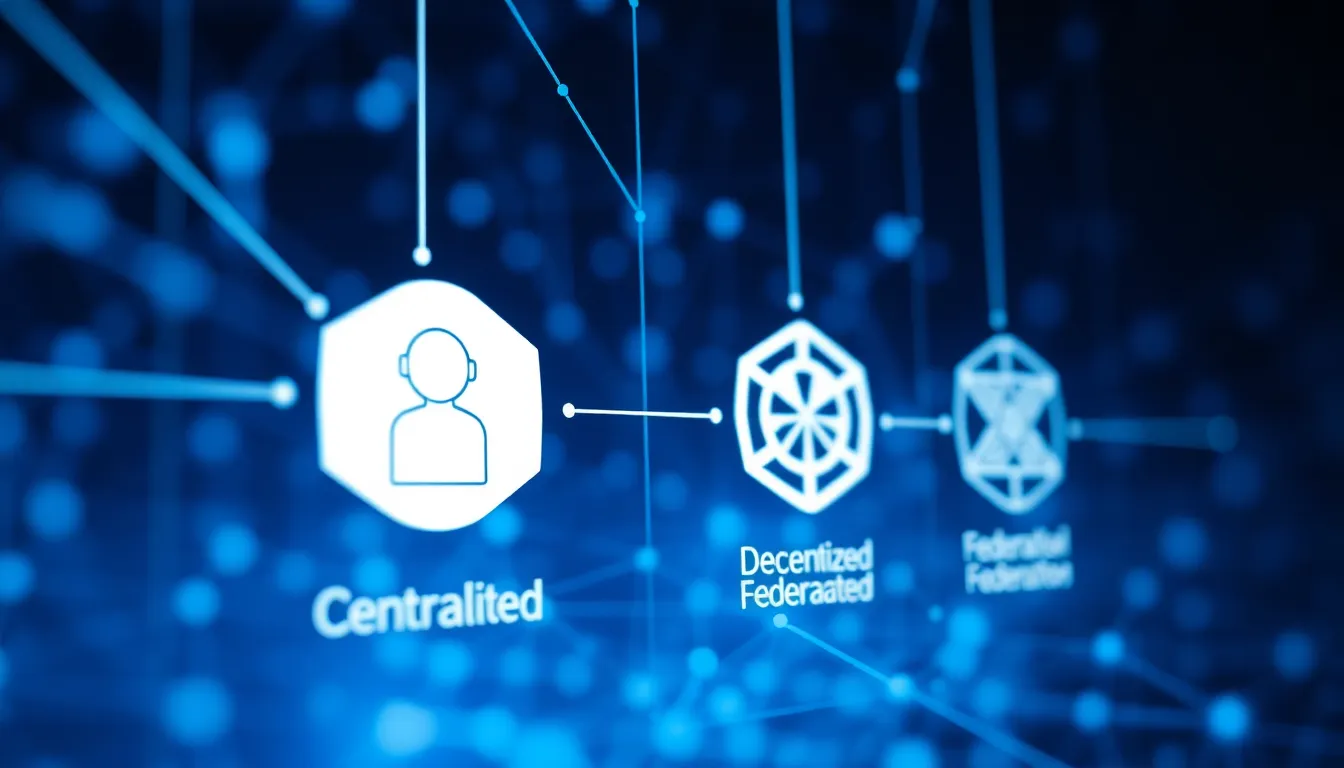In a world where passwords multiply faster than rabbits and online security feels like a game of whack-a-mole, digital identity systems are the superheroes we didn’t know we needed. These systems promise to simplify our online lives while keeping our personal information safer than a cat in a sunbeam. Who wouldn’t want a reliable way to prove they are who they say they are without the hassle of remembering yet another complicated password?
Table of Contents
ToggleOverview of Digital Identity Systems
Digital identity systems serve as innovative solutions to the complexities of online verification and personal security. These systems streamline identity confirmation, reducing the reliance on traditional passwords.
Definition and Purpose
Digital identity systems refer to technologies that securely manage personal identification information. These systems typically use biometrics, cryptographic methods, or blockchain to verify an individual’s identity. By doing so, they aim to facilitate secure access to online services, enhancing user convenience. Users can authenticate without needing multiple usernames and passwords, simplifying the login process.
Importance in Today’s Society
In today’s digital landscape, identity theft and data breaches pose significant risks. Digital identity systems enhance security by providing reliable methods for identity verification. They play a critical role in preventing fraud while promoting user privacy. Companies increasingly adopt these systems to protect sensitive customer information and boost trust. As online interactions grow, so does the necessity for robust digital identity solutions, making them crucial for both individuals and organizations.
Types of Digital Identity Systems

Digital identity systems come in various forms, each with unique functions suited for different applications. The three main types include centralized, decentralized, and federated identity systems.
Centralized Digital Identity
Centralized digital identity systems store user information in a single, central repository. This approach allows organizations to manage and verify identities efficiently. Users face a single point of authentication, simplifying the login process. However, centralization poses risks; a data breach could expose all user data at once. Major corporations often implement centralized systems due to their convenience and control over user data.
Decentralized Digital Identity
Decentralized digital identity systems focus on user control and privacy. Users maintain ownership of their personal data across multiple platforms without relying on a central authority. Blockchain technology often supports these systems, enhancing security through distributed ledgers. Authenticating identity becomes more secure and transparent, as users share data selectively. Decentralized systems aim to reduce the risk of identity theft and data breaches.
Federated Identity Systems
Federated identity systems connect multiple identity providers, allowing users to access various services with a single login credential. Trust between organizations eliminates the need to manage multiple passwords. Users benefit from improved convenience and enhanced security since their data remains with trusted providers. These systems widely support partnerships among organizations, facilitating seamless user experiences across platforms. By leveraging federated identities, users navigate online environments more efficiently.
Key Components of Digital Identity Systems
Digital identity systems rely on essential components to function effectively. These components enhance security and streamline user experiences across online platforms.
Authentication Methods
Biometrics offer a reliable authentication method, utilizing unique physical characteristics like fingerprints or facial recognition. Passwordless authentication also gains popularity, enabling users to log in through multi-factor verification without a traditional password. Cryptographic techniques enhance data security and protect user identities against unauthorized access. Single sign-on (SSO) systems allow users to access multiple services with one set of credentials, minimizing login fatigue and safeguarding personal information. These methods collectively strengthen identity verification and improve the overall security posture of digital identity systems.
Data Privacy and Security
Encryption plays a crucial role in safeguarding personal data within digital identity systems. Secure storage practices limit unauthorized access and ensure sensitive information remains protected. Regulatory compliance aligns data practices with standards, such as GDPR or CCPA, promoting user trust through transparent data handling. Real-time monitoring of data access helps detect potential security breaches, ensuring prompt action to address vulnerabilities. Overall, robust data privacy measures build confidence in digital identity systems and encourage widespread adoption.
User Control and Consent
User control underpins the effectiveness of digital identity systems. Participants possess the authority to manage their personal data preferences and sharing settings. Consent mechanisms ensure users actively agree to data collection practices, fostering a sense of security and autonomy. The implementation of privacy-by-design principles encourages organizations to prioritize user needs from the ground up, promoting fair data use. Ultimately, empowering users with control enhances engagement and reinforces trust in digital identity solutions.
Challenges and Issues
Digital identity systems face several challenges that can impact their effectiveness and adoption. Addressing these issues is crucial for enhancing user security and trust.
Cybersecurity Threats
Cybersecurity threats pose significant challenges to digital identity systems. Data breaches can compromise personal information stored within these systems. Attackers may exploit vulnerabilities, leading to unauthorized access and identity theft. Phishing attacks also target users, tricking them into revealing sensitive data. Protecting against these threats requires robust security measures, including strong encryption and continuous monitoring. Organizations must invest in advanced technologies to safeguard user data and mitigate risks effectively.
Regulatory and Compliance Concerns
Regulatory and compliance concerns significantly affect the implementation of digital identity systems. Various jurisdictions enforce stringent data protection regulations, requiring organizations to adhere to laws such as GDPR and CCPA. Non-compliance may result in substantial fines or legal repercussions for companies. Adopting necessary compliance measures can be complex; organizations must navigate diverse legal frameworks while ensuring user privacy. Furthermore, evolving regulations may require frequent system updates to maintain compliance, adding another layer of complexity to digital identity management.
Accessibility and Inclusivity
Accessibility and inclusivity present important challenges for digital identity systems. Ensuring that all users, regardless of abilities or technological proficiency, can effectively utilize these systems is crucial. Many digital identity systems may unintentionally exclude individuals with disabilities or those lacking access to advanced technology. Designing user-friendly interfaces and providing alternative authentication methods can promote inclusivity. Implementing these changes fosters a more equitable digital environment, allowing everyone to benefit from secure identity management solutions.
Future Trends in Digital Identity Systems
Digital identity systems rapidly evolve, reflecting technological advancements and societal needs. These systems adapt to enhance user experience and bolster security.
Emerging Technologies
Biometric innovations stand at the forefront of digital identity systems. Facial recognition, fingerprint scanning, and iris recognition create robust authentication methods. Blockchain technology ensures enhanced data security and reduces unauthorized access. Artificial intelligence plays a significant role in anomaly detection, flagging suspicious activities before breaches occur. Such technologies not only optimize user verification but also offer increased trust in digital transactions.
Integration with Other Systems
Interoperability is crucial for digital identity systems. These systems seamlessly work with payment platforms, social media channels, and government services. By linking authentication services, users experience streamlined access while maintaining security. Single sign-on solutions simplify user interactions across multiple platforms, reducing password fatigue. Organizations increasingly recognize the benefits of integrating identity solutions into existing infrastructure, reinforcing system effectiveness and user convenience.
Global Perspectives
Diverse countries approach digital identity differently, reflecting cultural and regulatory contexts. In India, the Aadhaar system exemplifies a nationwide biometric identification effort. European nations focus on privacy under frameworks like GDPR, prioritizing data protection. Meanwhile, developing countries leverage mobile technology to establish identities for underrepresented populations. Global collaboration on identity verification standards fosters trust, ultimately enhancing digital engagement and access across borders.
Digital identity systems are transforming the way individuals interact online by enhancing security and simplifying access. As the digital landscape continues to evolve, these systems offer innovative solutions to the challenges of identity management. With various types of systems available, users now have options that prioritize privacy and control while ensuring reliable authentication.
The ongoing development of technologies like biometrics and blockchain further strengthens the effectiveness of these systems. Addressing challenges such as cybersecurity threats and regulatory compliance will be crucial for their widespread adoption. Ultimately, digital identity systems represent a significant step toward a more secure and user-friendly online environment, fostering trust and protecting personal information in an increasingly interconnected world.






